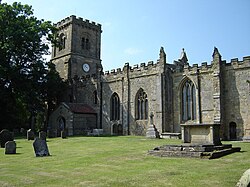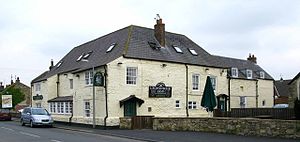Seamer, Scarborough
| Seamer | |
| Yorkshire North Riding | |
|---|---|
 St Martin’s Church | |
| Location | |
| Grid reference: | TA016836 |
| Location: | 54°14’18"N, 0°26’28"W |
| Data | |
| Population: | 4,335 (2011[1]) |
| Post town: | Scarborough |
| Postcode: | YO12 |
| Local Government | |
| Council: | Scarborough |
| Parliamentary constituency: |
Scarborough and Whitby |
Seamer is a village and parish in the North Riding of Yorkshire, to the south-west of Scarborough.
The ancient parish is composed of the townships of Seamer and Irton and the chapelry of East Ayton. The village of Seamer is built upon practically level ground and contains no features of any antiquity. The church of St Martin and the vicarage are in the centre. A short distance to the west of the church are some scanty remains of the manor-house. A ruined fragment of wall containing a 15th-century doorway is now all that is standing above ground, but extensive foundation mounds may be traced in connexion with it.[2]
Early history
Prehistoric Seamer
The first inhabitants of the parish were people of the Mesolithic Age about ten thousand years ago whose settlement at Star Carr was discovered in 1947. Next came the Bronze Age people, to be followed by the Romans who lived nearby. These in turn were succeeded by the Anglo Saxons. From Seamer Moor there would have been a good view of both Lake Pickering and the North Sea which would have given rise to the village name – SEA-MER(E). It was during this time that Seamer probably took shape as a village.[3]
The Star Carr Mesolithic archaeological site is located in the parish.[4] In August 2010, the team announced that they had discovered the oldest known house in Britain, dated to 10,500 years before the present. The Star Carr house was comparable to an Iron Age roundhouse, about 11 ft 6 in wide and made of wood. It is believed to have been used for between 200–500 years after its construction.[5]
In AD 70, the Romans crossed the River Humber and entered Yorkshire. With the construction of a vexillation fort, Derventio Brigantum at what is now Malton, roads to the coast were built. Archaeologists have speculated that a few years after this, a veteran soldier may have taken his retirement pension in the form of a land grant in the Seamer area, and constructed an early Roman-style farm on the land. A number of other Roman structures have been found in the Seamer area, one of which was probably an industrial premises.[6]
Hugh de Port, Lord of Seamer
Hugh de Port was born in 1030, Port-en-Bessin, Calvados, Normandy, France and died 1066 at Seamer. Semær (xi cent.); Semere (xi–xviii cent.); Semar (xii-xvi cent.); Seymer, Semour (xvi-xviii cent.).
Tostig, treacherous brother of Harold, the last Saxon King, held Holdenhurst prior to the Norman Conquest. After 1066, William the Conqueror first held it himself, later bestowing it upon Hugh de Port. Decades later it reverted to the Crown. [7]
In the reign of King Henry I, Hugh de Port’s son, Henry, founded the Priory of Sherborne, near Basing. The connection continued. John de Port, son of Henry, was succeeded by his son, Adam de Port. It is at this point that a family name change occurs. Adam de Port, Lord of Basing, married Mabel, daughter of Reginald de Aurevalle and his wife Muriel. Muriel was the daughter of Roger de St John, whose father, William de St John, was very close to William the Conqueror
William de St John, son of Adam de Port, assumed the name of his mother’s family and so Basing House became aligned with the name St John. [8]
History since 1086
Its name is first attested in the Domesday Book of 1086 as Semær, with later medieval attestations including Semare and Samara. The first element is Old English sǣ 'lake'; the spelling of the second element suggests variation between Old English mere 'sea' and Old Norse marr 'lake, sea, pool'. The dominant meaning of the name therefore seems to have been 'lake by the sea'. 'The reference was to a lake now drained in the area SW of the church at Seamer Carr TA 0281.[9]
Modern history

The summer of 1603 was an exceptionally long one, which prolonged the presence of the plague to the north of Seamer in Whitby, Robin Hoods Bay and Harwood Dale. Edward Gate, who owned the manor of Seamer, leased it to his son-in-law, Thomas Mompesson, in 1604. In 1609, the King granted Mompesson a market and fair, as in the reign of Richard II, and also a Court of Piepowders, which would be attached to the market and where justice could be dispensed immediately to criminals. Mompesson also petitioned the Earl of Salisbury to grant him the parsonage of Seamer and the chapels of Cayton and East Ayton. However, his "success was short lived," and by 1611, Scarborough had managed to get the market closed.[10]
In 1613, ownership of the manor passed to Sir Nicholas Salter, from London, and in 1623, the manor was again sold on to Edward Wareham and William Talbot. In 1625, the plague struck Scalby, and Sir Thomas Posthumous Hoby of Hackness effectively quarantined them. As McGeown notes, "People in all the surrounding villages would have been anxious."[11] In 1631, ownership of the manor was again sold on to Sir Robert Napier, 2nd Baronet, of Luton Hoo in Bedfordshire. On 19 March 1639, Napier wrote to the bailiffs and burgesses of Scarborough, asking for support in case he was to stand as Scarborough's MP, but he never represented the town.[12]
Following Charles I's failure in the Second Bishops' War in 1640, the defeated English army had not been paid and instead were forcibly billeted in parts of Yorkshire. One band of the Earl of Caernarvon's soldiers was billeted at Hutton Bushell and West Ayton. An outrage occurred when in 1640, the only local landowning gentleman, Roger Wyvill, spotted four of Caenarvon's soldiers attacking a traveller in Seamer, and tried to intervene. In return, he was chased down the street by the soldiers, only escaping by hiding in one of the fireplaces of the Seamer manor house. This matter was later brought before the authorities, where Wyvill described "The evil behaviour and grand abuses of the king's soldiers in his locality."[13]
When the Civil War broke out in August 1642, Sir Hugh Cholmeley, 1st Baronet, the MP for Scarborough, was sent north by Parliament to put the town in a state of readiness. Prior to this, Roger Wyvill, and his son Captain William Wyvill, had been recruiting for the king. However, in March 1643, Cholmeley was persuaded to change allegiances, and joined the Royalists. Following the Battle of Marston Moor in July 1644, and the Parliamentarian capture of York, Scarborough became the most important Royalist stronghold in Yorkshire. The owner of Seamer throughout this period remained Sir Robert Napier, who was a Royalist and whose estates in Bedfordshire and "presumably elsewhere" had been sequestered by Parliament. In January 1644, it is recorded that a camp of Parliamentarian soldiers was stationed in Seamer.[14] In February 1645, Sir John Meldrum captured the town, and began the siege of the castle, which concluded in a Parliamentarian victory on 25 July.
Seamer was a busy village in Norman times and from the eleventh century there has been a succession of Lords of the Manor. In 1066 Seamer had both a church and a priest so it must have been a place of some importance. By the middle of the twelfth century the original wooden Saxon church had been replaced with a stone building with a tower which served as a minor castle. In the fourteenth century the size of the Manor House was increased. The village became more affluent and in 1337 King Richard II granted a charter for an annual fair to be held. Despite the population being decimated by the 'Black Death' the village survived and flourished. By 1760 there were nine inns. During the 1800s Primitive and Wesleyan chapels were erected. The Victorian Board School was established in 1879 and the Parish Council was formed in 1894.The economy of the parish was based on agriculture and there were 27 farmers recorded in 1913.[3]

The most significant historic event connected with Seamer was an insurrection in 1549 in resulting from the dissolution of monasteries. The conspirators assembled about 3,000 people and proceeded to the house of one Mr. White, a gentleman who had rendered himself obnoxious to them. They broke into the house, captured the owner, Mr. Clapton, his brother-in-law, Mr. Richard Savage, sheriff of York, and a manservant, and carried them off to the Wolds, where they were stripped and murdered. The insurrection, however, was nipped in the bud. A detachment of soldiers from the garrison at York was sent to capture them; a free pardon was proclaimed by order of the King, but the three leaders and six others refusing the royal clemency were executed at York.[15]
With the establishment of the railway and the increase in public and private transport the quiet, peaceful parish of Seamer was ripe for expansion after the First World War. Large housing developments have taken place at Seamer and Crossgates since the 1960s and an industrial estate now occupies the south-eastern corner of the parish. In 1891 the population was 681 – the population now stands at some 4,000 and the community continues to expand, but it remains a pleasant dormitory parish.
According to the 2011 UK census, Seamer parish had a population of 4,335,[1] an increase on the 2001 UK census figure of 3,774.[16] In 2017 plans were approved to build 241 new homes in Seamer.[17]

It is served by a railway station which is on the Yorkshire Coast Line that runs between Hull and Scarborough. It is also served by the Scarborough branch of the North TransPennine service from York. It also has a school, and has several communal clubs held around the village.
Notes
- ↑ 1.0 1.1 UK Census (2011). "Local Area Report – Seamer Parish (1170217361)". Nomis. Office for National Statistics. https://www.nomisweb.co.uk/sources/census_2011_ks/report?compare=1170217361. Retrieved 11 March 2018
- ↑ http://www.british-history.ac.uk/report.aspx?compid=64696
- ↑ 3.0 3.1 "History". Archived from the original on 14 August 2010. https://web.archive.org/web/20100814235146/http://www.seamercrossgates.plus.com/history.htm. Retrieved 2015-08-10.
- ↑ Cf. Victor Watts (ed.), The Cambridge Dictionary of English Place-Names, Based on the Collections of the English Place-Name Society (Cambridge: Cambridge University Press, 2004), s.v. SEAMER.
- ↑ Coughlan, Sean (10 August 2010). "Archaeologists discover Britain's 'oldest house'". BBC News. https://www.bbc.co.uk/news/education-10929343. Retrieved 9 February 2013.
- ↑ McGeown, pp. 9–10
- ↑ http://www.opcdorset.org/Holdenhurst/Holdenhurst.htm
- ↑ http://www.hampshire-history.com/basing-house-before-the-civil-war
- ↑ Victor Watts (ed.), The Cambridge Dictionary of English Place-Names, Based on the Collections of the English Place-Name Society (Cambridge: Cambridge University Press, 2004), s.v. SEAMER.
- ↑ McGeown, p. 75
- ↑ McGeown, p. 78
- ↑ McGeown, p. 76–77
- ↑ McGeown, p. 79
- ↑ McGeown, p. 80
- ↑ https://stmartinsseamer.wordpress.com/history/
- ↑ "2001 Census: Key Statistics: Parish Headcounts: Area: Seamer CP (Parish)". Neighbourhood Statistics. Office for National Statistics. http://neighbourhood.statistics.gov.uk/dissemination/LeadTableView.do?a=3&b=798218&c=Seamer&d=16&e=15&g=476946&i=1001x1003x1004&m=0&r=1&s=1215468237623&enc=1&dsFamilyId=779. Retrieved 7 July 2008.
- ↑ "Plans For New Homes In Seamer Approved". Yorkshire Coast Radio. 9 August 2017. https://www.yorkshirecoastradio.com/news/local-news/2350286/plans-for-new-homes-in-seamer-approved/. Retrieved 13 February 2018.
References
- Binns, Jack (2001). The History of Scarborough, North Yorkshire: From Earliest Times to the Year 2000. Pickering: Blackthorn Press. ISBN 0953507270.
- McGeown, Sheila (2015). A History of Seamer: In the County of North Yorkshire. Croydon: Blackthorn Press. ISBN 1906259437.
Outside links
| ("Wikimedia Commons" has material about Seamer, Scarborough) |
